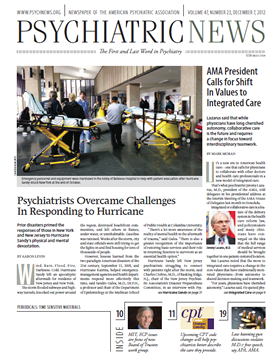When it comes to Internet usage and social media, the boundary defining professionalism for physicians is not always clear. Many patients expect to be able to e-mail their physicians about medical information, and relationships among physicians now have the ability to cross new boundaries via social media.
Sandra DeJong, M.D., Sheldon Benjamin, M.D., Joan Meyer Anzia, M.D., and their colleagues addressed the liabilities, safety issues, academic issues, boundaries and “netiquette,” and potential conflicts of interest that can arise when physicians use the Internet, and social media in particular, in the September Academic Psychiatry.
“The evidence of unprofessional online behavior among physicians and the complexity of the potential issues raised with Internet use in psychiatry suggest that psychiatric residents, educators, and administrators need explicit teaching about potential clinical, ethical, and legal pitfalls of Internet use,” the authors noted.
In 2010, the American Association of Directors of Psychiatric Residency Training (AADPRT) established the Task Force on Professionalism and the Internet to review information on the issue and create a curriculum to teach psychiatric trainees the basics of online professionalism. The task force’s workshop, held during AADPRT’s 2010 annual meeting, asked participants to describe concerns about topics ranging from social-media use to academic issues associated with online professionalism.
DeJong and colleagues used several participant vignettes from that workshop in their report to help illustrate relevant issues that participants raised.
One such issue concerns e-mail. Psychiatrists often communicate with patients via e-mail, which raises issues about liability with regard to response time. For example, a psychiatrist on vacation received an urgent e-mail from his patient and could not respond quickly enough before the patient attempted suicide. Even though the psychiatrist set up voicemail and an on-call beeper with instructions to contact a coworker, the patient relied on e-mail as the form of communication based on previous interactions with the psychiatrist.
In situations such as this, Dejong suggested that psychiatrists have patients sign an e-mail consent form and use protected portals or encryption software to avoid confidentiality issues when e-mailing patients.
E-mail is not the only technology that can cause privacy and confidentiality concerns. There are potential pitfalls as well when psychiatrists use social media. The AMA’s policy, titled Professionalism in the Use of Social Media, suggests separating personal online content from professional online content. The policy states, “when using the Internet for social networking, physicians should use privacy settings to safeguard personal information and content to the extent possible, but should realize that privacy settings are not absolute and that once on the Internet, content is likely there permanently.” (The policy is posted at
http://www.ama-assn.org/ama/pub/meeting/professionalism-social-media.shtml.)
The AMA’s policy on social media also suggests using the privacy features within social-media platforms, but warns that the privacy features are not absolute and recommends that physicians manually monitor their online persona as well.
Sometimes separating professional and personal online information can be difficult and can affect treatments such as psychotherapy. “The psychotherapy principles of neutrality, anonymity, and abstinence may be compromised when a patient accesses a trainee’s postings,” the authors pointed out.
They noted that patients may be able to see a psychiatry resident’s past posts, sometimes even ones that occurred before the resident began his or her professional education or career, thus possibly compromising the psychiatrist’s professional identity or making the patient uncomfortable divulging sensitive material.
Another potential problem can arise when patients have negative experiences with their psychiatrist and decide to go online to voice their frustrations, which can be detrimental to psychiatrists’ professional image or career.
“Unfortunately, some disgruntled individuals can post false and harmful content online; residents need to recognize such defamation and seek legal counsel and/or the services of a reputation-defender company,” advised DeJong and her colleagues.
Their report also addresses academic concerns, such as plagiarism, and the basic aspects of “netiquette,” which can extend to punctuation, word choice, and greetings and can have a sizable impact on an electronic message due to the lack of nonverbal cues.
The authors presented the following suggestions for educators teaching residents about online professionalism:
•.
Respect varying attitudes on social media that may be held by different generations.
•.
Do not assume that trainees recognize professionalism issues.
•.
Teach interactively using vignettes that will resonate with the residents’ own experiences.
•.
Use vignettes that address issues of liability, confidentiality and privacy, psychotherapy and boundaries, libel, conflicts of interest, and netiquette.
•.
Emphasize the overarching concepts of online professionalism rather than the actual technology itself, which will be constantly evolving.
•.
Provide references, including institutional guidelines and code of ethics, to help trainees maintain a professional online identity.
“Physicians must carefully construct their online personae in a manner consistent with long-standing principles of professionalism,” the authors emphasized. “It is up to psychiatric educators to train a new generation of psychiatrists to think through the professionalism issues raised by online technology, including technologies not yet invented.”

